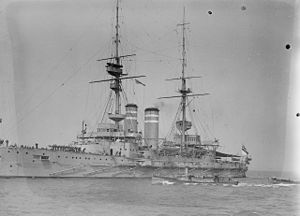HMS Queen (1902)
 HMS Queen, c. 1909
| |
| History | |
|---|---|
| Name | HMS Queen |
| Builder | Devonport Dockyard |
| Laid down | 12 March 1901 |
| Launched | 8 March 1902 |
| Completed | March 1904 |
| Commissioned | 7 April 1904 |
| Decommissioned | November 1919 |
| Fate | Broken up , 1921 |
| General characteristics | |
| Class and type | London-class battleship |
| Displacement |
|
| Length | 431 ft 9 in (131.6 m) o/a |
| Beam | 75 ft (22.9 m) |
| Draught | 26 ft (7.9 m) |
| Installed power |
|
| Propulsion |
|
| Speed | 18 knots (33 km/h; 21 mph) |
| Complement | 714 |
| Armament |
|
| Armour | |
HMS Queen was a member of the
in 1914.After the outbreak of the
Design

The five ships of the London class were ordered in 1898 in response to increased naval construction for the
Queen was 431 feet 9 inches (131.60 m)
Queen had a
Queen had an armoured belt that was 9 inches (229 mm) thick; the transverse bulkheads on the aft end of the belt was 9 to 12 in (229 to 305 mm) thick. Her main battery turrets sides were 8 to 10 in (203 to 254 mm) thick, atop 12 in (305 mm) barbettes, and the casemate battery was protected with 6 in of Krupp steel. Her conning tower had 14 in (356 mm) thick sides as well. She was fitted with two armoured decks, 1 and 2.5 in (25 and 64 mm) thick, respectively.[3]
Service history
Pre-World War I
HMS Queen was
HMS Queen was
World War I
When
In March 1915, as the British and French fleets waging the
Queen, Implacable, London, and Prince of Wales were transferred to the 2nd Detached Squadron, organised to reinforce the Italian Navy in the Adriatic Sea when Italy declared war on Austria-Hungary. She arrived at her new base, Taranto, Italy, on 27 May 1915.[12][13] From December 1916 to February 1917, Queen was refitted for service as a depot ship for the personnel of the Otranto Barrage that attempted to block German and Austro-Hungarian U-boats from passing through the Strait of Otranto. Most of her crew returned to the United Kingdom, leaving only a care-and-maintenance crew behind, and she was gradually disarmed as her guns were allocated to other duties. Most of her 6-inch (150 mm) guns had been removed by April 1917, and all of her 12-inch (300 mm) guns had been put ashore by October 1917, where they were turned over to the Italian Army for use in repelling attacks by the Austro-Hungarian Army, although the turrets were left aboard. Queen became flagship of British Naval Forces, Taranto, serving as such until February 1918.[12]
Postwar career
Queen left Taranto and returned to the United Kingdom in April 1919 and was placed on the disposal list at
Footnotes
Notes
- 3rd Battle Squadron, First Fleet.[8]
Citations
- ^ Burt, pp. 206–209.
- ^ Burt, p. 248.
- ^ a b c Lyon & Roberts, p. 37.
- ^ Burt, p. 253.
- ^ "Naval & Military intelligence". The Times. No. 36401. London. 13 March 1901. p. 7.
- ^ "Royal launches and H.M.S. Queen". The Times. No. 36711. London. 10 March 1902. p. 6.
- ^ a b Burt, p. 259.
- ^ Preston, p. 8.
- ^ Burt, pp. 201, 203.
- ^ Corbett 1920, pp. 76, 98, 227–229, 259–261.
- ^ Corbett 1921, pp. 208, 227, 310–324.
- ^ a b c Burt, p. 260.
- ^ Corbett 1923, p. 24.
References
- Burt, R. A. (2013) [1988]. British Battleships 1889–1904. Barnsley: Seaforth Publishing. ISBN 978-1-84832-173-1.
- OCLC 174823980.
- Corbett, Julian Stafford (1921). Naval Operations: From The Battle of the Falklands to the Entry of Italy Into the War in May 1915. Vol. II. London: Longmans, Green & Co. OCLC 924170059.
- Corbett, Julian Stafford (1923). Naval Operations: The Dardanelles Campaign. Vol. III. London: Longmans, Green & Co. OCLC 174824081.
- Lyon, David & Roberts, John (1979). "Great Britain and Empire Forces". In Chesneau, Roger & Kolesnik, Eugene M. (eds.). Conway's All the World's Fighting Ships 1860–1905. Greenwich: Conway Maritime Press. pp. 1–113. ISBN 978-0-85177-133-5.
- Preston, Antony (1985). "Great Britain and Empire Forces". In Gardiner, Robert & Gray, Randal (eds.). Conway's All the World's Fighting Ships 1906–1921. Annapolis: Naval Institute Press. pp. 1–104. ISBN 978-0-87021-907-8.
Further reading
- ISBN 978-1-86176-281-8.
- Dittmar, F. J. & Colledge, J. J. (1972). British Warships 1914–1919. London: Ian Allan. ISBN 978-0-7110-0380-4.
- Gibbons, Tony (1983). The Complete Encyclopedia of Battleships and Battlecruisers: A Technical Directory of All the World's Capital Ships From 1860 to the Present Day. London: Salamander Books Ltd. ISBN 978-0-86101-142-1.
- Parkes, Oscar (1990) [1957]. British Battleships. Annapolis: Naval Institute Press. ISBN 978-1-55750-075-5.
- Pears, Randolph (1979). British Battleships 1892–1957: The Great Days of the Fleets. London: G. Cave Associates. ISBN 978-0-906223-14-7.
